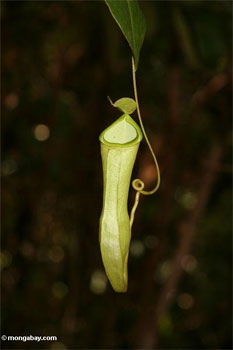Cure for cancer, AIDS may be lost with Borneo’s forests says WWF
WWF International
April 26, 2006
Gland, Switzerland — Plants that could help treat or cure diseases such as cancer, AIDS and malaria have been found in the forests of the heart of Borneo, according to a new WWF report. But the global conservation organization says this medical treasure trove is threatened and calls for its long-term protection.
The report — Biodiscoveries, Borneo’s Botanical Secret — reveals that scientists are currently testing samples collected in the Malaysian states of Sabah and Sarawak, as well as in Kalimantan, the Indonesian part of Borneo. They hope to develop drugs that could contribute to the treatment of major, deadly human diseases.
According to the report, Cerylid Biosciences — an Australian pharmaceutical company — has identified a promising anti-cancer substance in a shrub found in Sarawak. A compound present in the plant Aglaia leptantha has been found to effectively kill 20 kinds of human cancer cells in laboratory tests, including those that cause brain and breast cancer, and melanoma.
“The fact that the compound is very effective against a number of tumour cells, presents a very good argument for preserving the plant’s habitat in Borneo,” said Dr Murray Tait, Vice President of Drug Discovery at Cerylid Biosciences.
 Pitcher plant in Borneo [Photo by R. Butler] RELATED ARTICLES |
|
“More forest destruction could well deny science the opportunity to discover and develop further potential sources of life-saving medication.”
Scientists also found a unique chemical in latex produced by the Bintangor tree. The compound, Calanolide A, appears to be effective against the replication of the Human Immunodeficiency Virus (HIV), as well as the tuberculosis bacterium, which affects many AIDS patients. The discovery is particularly important as, to date, no single drug has been able to treat both HIV and TB. If clinically proven, Calanolide A could be a major development for the health of many millions of people worldwide.
The report further says that researchers found a powerful and previously unknown anti-malarial agent in the bark of a local tree traditionally used by the Kenyah people of Kalimantan to treat malaria. The substance — a triterpenoid — apparently kills the human malaria parasite Plasmodium falciparum in laboratory tests.
According to WWF, 422 new plant species have been discovered in Borneo in the last 25 years, and many other species are waiting to be found and studied, some of them could hold potentially important medical properties. However, the global conservation organization warns that all these promising discoveries could be eventually lost if the disappearing rainforests of the heart of Borneo are not adequately protected.
“It takes a long time before a substance found in a plant can be developed as an efficient drug and used by doctors,” said Dr Menno Schilthuizen, an associate professor with the University Malaysia Sabah and the author of the report. “I believe that hundreds of plants have been screened, dozens of compounds have been identified, but only a few of them are now clinically tested.”
Indigenous peoples such as the Kenyah can also potentially benefit from the development of drugs based on their traditional knowledge. The Convention on Biological Diversity, to which Indonesia and Malaysia are both parties, stipulates that indigenous communities should approve of the use of their traditional knowledge and that any benefits from its use should be shared equitably with them. The Convention also recognizes the sovereign rights of States over their genetic resources so that the development of drugs or other uses are subject to the laws of the country of origin.
Today, only half of Borneo’s forest cover remains, down from 75 per cent in the mid 1980s. But the three Bornean governments — Brunei Darussalam, Indonesia and Malaysia — have recently launched the Heart of Borneo initiative, which aims to preserve approximately 220,000km2 of equatorial forests and numerous wildlife species.
“We hope that the Bornean governments will sign a tri-country Declaration for the Heart of Borneo very soon,” said Mike Kavanagh, Chief Executive Director of WWF-Malaysia. “Such a declaration would ensure long-term protection to a region which might contain some of tomorrow’s most significant medical discoveries.”
This is a news release from WWF International. The report — Biodiscoveries, Borneo’s Botanical Secret — can be found at assets.panda.org/downloads/biodiscoveriesborneosbotanicalsecret.pdf [32.8 megabytes]